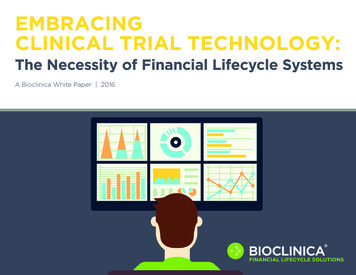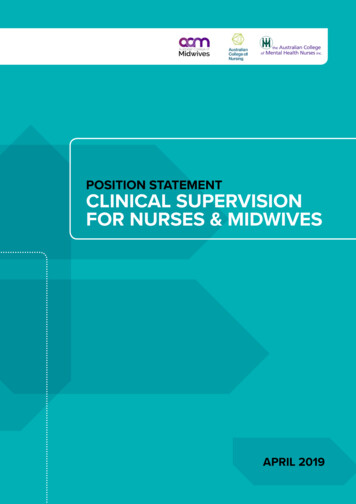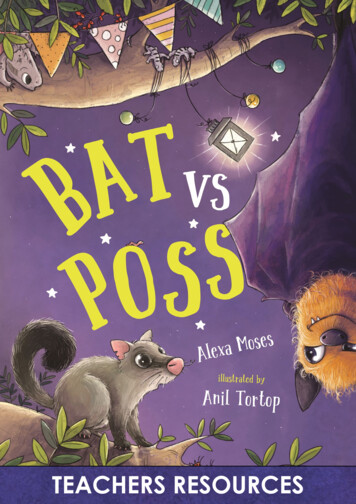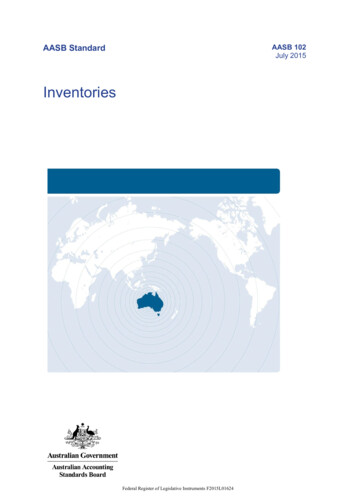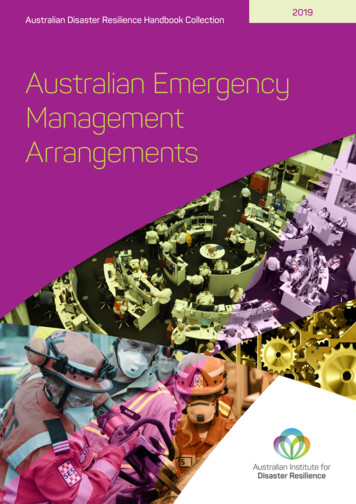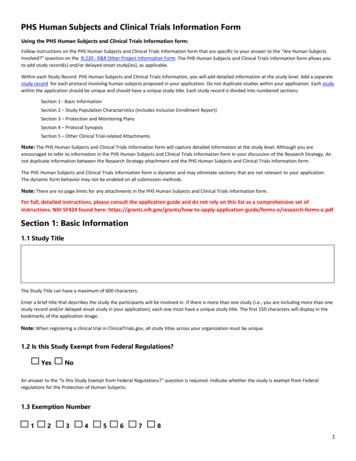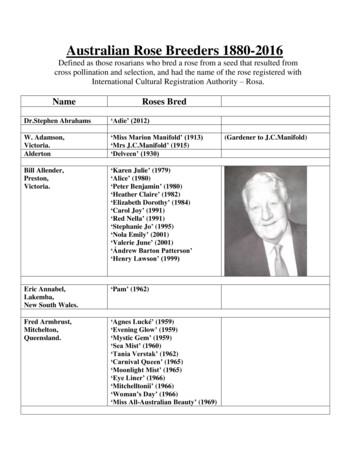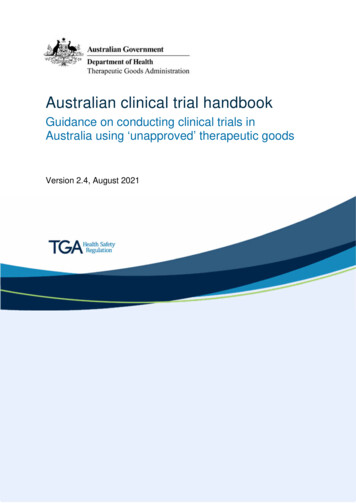
Transcription
Australian clinical trial handbookGuidance on conducting clinical trials inAustralia using ‘unapproved’ therapeutic goodsVersion 2.4, August 2021
Therapeutic Goods AdministrationCopyright Commonwealth of Australia 2021This work is copyright. You may reproduce the whole or part of this work in unaltered form for your own personal use or, ifyou are part of an organisation, for internal use within your organisation, but only if you or your organisation do not use thereproduction for any commercial purpose and retain this copyright notice and all disclaimer notices as part of thatreproduction. Apart from rights to use as permitted by the Copyright Act 1968 or allowed by this copyright notice, all otherrights are reserved and you are not allowed to reproduce the whole or any part of this work in any way (electronic orotherwise) without first being given specific written permission from the Commonwealth to do so. Requests and inquiriesconcerning reproduction and rights are to be sent to the TGA Copyright Officer, Therapeutic Goods Administration, PO Box100, Woden ACT 2606 or emailed to tga.copyright@tga.gov.au .Australian clinical trial handbookV2.4 August 2021Page 2 of 62
Therapeutic Goods AdministrationContentsAbout this handbook 6Clinical trials involving therapeutic goods 7Is the product a therapeutic good? 8Determine the type of therapeutic good 8Types of therapeutic goods ----------- 10Determine if the product is ‘unapproved’ 11Other pathways for accessing ‘unapproved’ therapeutic goods -------------- 12Certain ‘unapproved’ therapeutic goods used in clinical trials 12Placebos ------------------------------------ 12Comparators ------------------------------ 12Medical software and mobile medical ‘apps’ --------------------------------------- 13Laboratory kits and procedure packs ------------------------------------------------ 13Non-investigational products used in clinical trials------------------------------ 13Genetically Modified Organisms (GMO) --------------------------------------------- 13The Australian regulatory environment 14Therapeutic goods legislation 14Legislative and regulatory provisions for the CTN and CTA schemes ------- 14Declaration of Helsinki 16The National Statement on Ethical Conduct in Human Research 16Good Clinical Practice (GCP) 16Guideline for Good Clinical Practice -------------------------------------------------- 16ISO 14155 ---------------------------------- 17State and territory requirements 17The CTN and CTA schemes 18Choosing between the CTN and CTA schemes 18Medicines and biologicals ------------- 18Medical ---------------------------------- 19The CTN scheme 19Variations to a CTN ---------------------- 20Notification of completion of a clinical trial under a CTN ----------------------- 20The CTA scheme 20CTA forms --------------------------------- 21Variation to a CTA ---------------------- 21Australian clinical trial handbookV2.4 August 2021Page 3 of 62
Therapeutic Goods AdministrationNotification of a trial completion under a CTA---- Error! Bookmark not defined.Extensions of clinical trials 21Post-trial provisions 21Responsibilities under the CTN and CTA schemes 23Role of trial sponsors 23Sponsor definition ----------------------- 23Trial sponsors and the therapeutic goods legislation --------------------------- 23Investigator-initiated trials ----------- 24Trial sponsor oversight of delegated functions ----------------------------------- 24Reporting a change or transfer of trial sponsor ----------------------------------- 24Trial sponsor responsibility of trial management and monitoring ---------- 25Conducting ongoing safety evaluation and safety reporting ------------------- 25Record keeping obligations ----------- 25Registration of trial --------------------- 26Notifying trial sites ---------------------- 26Role of Human Research Ethics Committees (HRECs) 26HRECs and the therapeutic goods legislation -------------------------------------- 27The HRECs’ role in monitoring a clinical trial -------------------------------------- 27Withdrawal of approval by a HREC - 28Role of approving authorities 29Approving authorities and the therapeutic goods legislation ----------------- 29Site authorisation ------------------------ 29Monitoring by the approving ----- 29Role of principal investigators 30Role of TGA 30Requests for information -------------- 30When further action is required ----- 31Release of information ----------------- 32Concerns or complaints about a clinical trial -------------------------------------- 32Safety reporting to TGA for CTN and CTA trials 33Safety reporting timeframes for CTN and CTA trials 341. Single case events from Australian sites: SUSARS and USADEs ------------ 342. Significant safety issues* and overseas regulatory action ------------------- 363. Other report ------------------------- 37Single case events from Australian sites: SUSARs and USADEs 37Managing blinded trials ---------------- 37Australian clinical trial handbookV2.4 August 2021Page 4 of 62
Therapeutic Goods AdministrationReporting of overdoses and interactions between therapeutic goods ------ 38Significant safety issues including urgent safety measures 40Other report types 42Non-Australian SUSARs and USADEs ------------------------------------------------- 42Reports from post-market studies -- 42Clinical trial phases and stages 43Summary of clinical trial phases for medicines and biologicals 43Summary of clinical trial stages for medical devices 45Early phase trials 45Medical device stages 48Advertising ‘unapproved’ therapeutic goods 49Manufacturing 50Manufacturing medicines and biologicals for use in a clinical trial 50Manufacture in Australia -------------- 50Manufacture overseas ------------------ 51Labelling medicines --------------------- 52Manufacturing medical devices for use in a clinical trial 53Manufacturing records and evidence of compliance ----------------------------- 54Technical documentation ------------- 54Labelling medical devices ------------- 55Manufacturing exemptions 55Manufacturing exemptions for medicines and biologicals --------------------- 55Manufacturing exemptions for medical devices----------------------------------- 56Importing 57Import restrictions for therapeutic goods 57Importing therapeutic goods for use in clinical trials in Australia 57Six monthly reports 58Retrieval, destruction and export of unused clinical trial material 59Australian clinical trial handbookV2.4 August 2021Page 5 of 62
Therapeutic Goods AdministrationAbout this handbookThis handbook provides guidance on the legislative, regulatory and good clinical practice (GCP)requirements when conducting clinical trials in Australia using ‘unapproved’ therapeutic goods.It assists trial sponsors, Human Research Ethics Committees (HRECs), investigators andapproving authorities (institutions) to understand their roles and responsibilities under thetherapeutic goods legislation.Information about clinical trials for consumers can be found on the Australian Clinical Trialswebsite.This handbook does not describe all of the requirements for conducting clinical trials inAustralia. It refers to other relevant publications throughout that should be read in conjunctionwith this guidance.This handbook describes the two schemes under which clinical trials involving ‘unapproved’therapeutic goods may be conducted in Australia: Clinical Trial Notification (CTN) schemeClinical Trial Approval (CTA) schemeClinical trials that do not involve the use of ‘unapproved’ therapeutic goods are not subject to therequirements of the CTN and CTA schemes.This guidance has been developed by the Therapeutic Goods Administration(TGA) and therefore the use of ‘we’ and ‘us’ throughout refers to TGA.See TGA glossary for definitions relevant to the regulation of therapeutic goodsin Australia.Australian clinical trial handbookV2.4 August 2021Page 6 of 62
Therapeutic Goods AdministrationClinical trials involving therapeutic goodsClinical trials involving therapeutic goods are generally undertaken to assess the effects, efficacy,performance and/or safety of the product. It is therefore necessary that clinical trials areconducted using appropriate experimental designs to obtain valid data without exposingparticipants to unnecessary risks.Before starting a clinical trial, all parties should be satisfied that the rights, safety and well-beingof trial participants will be protected and that clinical trial data generated will be reliable androbust. To achieve such objectives, clinical trials involving ‘unapproved’ therapeutic goods mustbe conducted in accordance with: the requirements of the therapeutic goods legislation the National Statement on Ethical Conduct in Human Research (the National Statement) as inforce from time to time other relevant requirements of Commonwealth and/or state and territory legislation the principles that have their origin in the World Medical Association Declaration of Helsinki the relevant Good Clinical Practice (GCP) guideline site specific requirementsSee the Clinical Trials Toolkit on the Australian Clinical Trials website for further informationand useful resources.Before conducting a clinical trial in Australia, the trial sponsor will need to consult a HREC todetermine whether an exemption under the CTN scheme or approval under the CTA scheme isrequired for the trial.Clinical trials that do not involve the use of ‘unapproved’ therapeutic goods arenot subject to CTN or CTA requirements. However, all clinical trials requireHREC approval before the clinical trial may commence.The trial sponsor will need to determine the following for each product used in the clinical trial:1.2.3.Is the product a therapeutic good (and therefore regulated as a therapeutic good)The type of therapeutic good (and therefore regulated as a medicine, medical device orbiological)If the product is considered ‘unapproved’ (and therefore a CTN or CTA submission isrequired)Australian clinical trial handbookV2.4 August 2021Page 7 of 62
Therapeutic Goods AdministrationIs the product a therapeutic good?The trial sponsor must first determine whether any of the products to be used in a clinical trialmeet the definition of a therapeutic good and are regulated under the therapeutic goodslegislation.The following guidance may assist trial sponsors to determine if a product is a therapeutic good: What are ‘therapeutic goods’? provides definitions and examples of therapeutic goodsIs my product a therapeutic good? is an online tool designed to assist in determiningwhether a product is a therapeutic good, and if so, the type of therapeutic good (althoughthis is not specifically designed for clinical trials)Food and medicine regulation and the Food-Medicine Interface Guidance Tool may assist inidentifying whether a product is regulated as a medicine or a foodSection 3 of the Therapeutic Goods Act 1989 provides definitions for therapeutic goods andtherapeutic use. Although the term ‘therapeutic use’ is sometimes used in connection with phaseIV clinical trials for medicines and biologicals, for the purposes of the CTN and CTA schemes, theuse of a medicine or biological in a phase I, II or III clinical trial will also generally be consideredto be for therapeutic use. A medicine, biological or medical device that is the subject of a clinicaltrial will generally be considered to be a therapeutic good regardless of the phase or stage of thetrial.Determine the type of therapeutic goodThe trial sponsor needs to correctly identify the type(s) of therapeutic good(s)being supplied in a clinical trial as different regulatory requirements apply.This handbook describes the regulation of three main types of therapeutic goods: medicines (including prescription medicines, over-the-counter medicines andcomplementary medicines) biologicals (including human cell and tissue-based therapeutic goods, or live animal cells,tissues and organs) medical devices (including in vitro diagnostic medical devices (IVDs))See Products regulated as biologicals for information on therapeutic goods thatare regulated as biologicals. Biological prescription medicines (for example,vaccines that do not contain human cells, plasma derivatives, recombinantproducts) are not regulated by us as biologicals. They are regulated asmedicines.We also regulate a fourth, very limited, type of goods known as other therapeutic goods (OTGs).These include sterilants, disinfectants and tampons.Australian clinical trial handbookV2.4 August 2021Page 8 of 62
Therapeutic Goods AdministrationUse of the term ‘investigational’ in this handbook is explained below: investigational product - any therapeutic good (including placebos) beingtested or used as reference in a clinical trial investigational biological - an investigational product that is a biological investigational medicinal product - an investigational product that is amedicineinvestigational medical device - a medical device being assessed for safetyor performance in a clinical investigationAustralian clinical trial handbookV2.4 August 2021Page 9 of 62
Therapeutic Goods AdministrationTypes of therapeutic goodsRefer to the Therapeutic Goods Act 1989 for the complete definitions.Australian clinical trial handbookV2.4 August 2021Page 10 of 62
Therapeutic Goods AdministrationDetermine if the product is ‘unapproved’Therapeutic goods must be included in the Australian Register of Therapeutic Goods (ARTG)before those goods can be lawfully imported into, exported from or supplied in Australia unlessotherwise the subject of an exemption, approval or authority under the Therapeutic Goods Act1989.The therapeutic goods legislation provides a number of avenues to allow access to therapeuticgoods that are not included in the ARTG. The CTN and CTA schemes provide for the lawfulimportation into and/or supply in Australia of ‘unapproved’ therapeutic goods for use solely forexperimental purposes in humans.For the purposes of this handbook, the reference to ‘unapproved’ therapeutic goods is anabbreviated expression1 which is intended to include: any medicine not included in the ARTG, such as any new formulation, strength or size,dosage form, name, indications, directions for use or type of container of a medicine alreadyin the ARTGany medical device (including an in vitro diagnostic device (IVD)) not included in the ARTG,such as any new sponsor, manufacturer, device nomenclature system code, classification orunique product identifier (for certain classes of medical devices only) of a medical devicealready in the ARTG– any biological not included in the ARTG such as:–– any in-house IVD medical device, used for the purpose of a clinical trial, where thelaboratory providing the in-house IVD is unable to comply with the regulatoryrequirements for in-house IVDs (a laboratory developed test used for researchpurposes where results of such testing are not being used in patient diagnosis,treatment or management decisions would not be considered an in-house IVD)any new applicable standards, intended clinical use or principal manufacturer of a Class1 or 2 biological already in the ARTGany new product name, dosage form, formulation or composition, therapeuticindication, type of container or principal manufacturer of a Class 3 or 4 biologicalalready in the ARTGtherapeutic goods already included in the ARTG to be used in a manner not covered by theexisting entry in the ARTGThe overall decision as to whether a CTN or CTA is required in relation to theuse of the therapeutic goods is the responsibility of the trial sponsor.Consultation with the HREC that will approve the trial protocol may assist inthe decision.When a product is included in the ARTG, the entry applies to a particular sponsor (i.e. theindividual or company intending to supply the goods). If a same or similar product is importedby another company or individual it is considered ‘unapproved’.Trial sponsors who are considering supplying an ‘unapproved’ therapeutic good, need torecognise that it has not been evaluated by us for quality, safety, efficacy or performance.The use of the expression ‘unapproved’ in this handbook refers to the international expression ‘approvalfor general marketing’. It does not refer to the absence of any express statutory approval under thetherapeutic goods legislation, but rather the absence of any registration, listing or inclusion of thetherapeutic goods in the ARTG.1Australian clinical trial handbookV2.4 August 2021Page 11 of 62
Therapeutic Goods AdministrationOther pathways for accessing ‘unapproved’ therapeutic goodsThe CTN and CTA schemes are not intended to be used as a means for obtaining access to‘unapproved’ therapeutic goods for an individual patient. There are other mechanisms forlawfully supplying ‘unapproved’ therapeutic goods to individual patients outside clinical trials.Those mechanisms are: Special Access Scheme (SAS) Personal Import Scheme Authorised Prescriber SchemeEqually, the above pathways should not be used by health practitioners for the purposes ofconducting a clinical trial. Health practitioners wanting to conduct a clinical trial (investigatorinitiated trials) using an ‘unapproved’ therapeutic good, should do so using the CTN or CTApathways, as appropriate.The 'Authorised Prescriber' mechanism may be suitable to allow the lawful supply of the'unapproved' therapeutic goods in a study that is not defined as a clinical trial. ‘Clinical trials’ aredefined on our webpage. The TGA does not advise on study design or whether a study is definedas a ‘clinical trial’. Sponsors should seek advice from the approving HREC.In determining which pathway to use, it would also be advisable to consider the ethicalacceptability of supplying an 'unapproved' therapeutic good outside the intent and purpose ofeach scheme.The regulatory controls placed on clinical trials conducted through the CTN and CTA pathwaysprovide sufficient assurance that high quality, credible data that contribute to the answering ofspecific scientific questions is collected, while also protecting the rights, safety and well-being ofclinical trial participants.Certain ‘unapproved’ therapeutic goods used in clinicaltrialsAll ‘unapproved’ therapeutic goods, not just the investigational product(s),must be the subject of an exemption, approval or authority under theTherapeutic Goods Act 1989 to be lawfully supplied in a clinical trial.PlacebosThere is no entry for ‘placebo’ in the ARTG. Therefore, a placebo is considered to be an‘unapproved’ therapeutic good and a CTN or CTA must be in place before a placebo can besupplied for use in a clinical trial. This is the case even if the investigational product(s) arealready included in the ARTG.ComparatorsA comparator is an investigational or marketed product, or placebo, used as a reference in aclinical trial. If the trial sponsor determines a comparator to be an ‘unapproved’ therapeuticgood, then a CTN or CTA must be in place before the product can be supplied for use in a clinicaltrial. This includes comparators that are included in the ARTG and altered for the purposes of atrial.Australian clinical trial handbookV2.4 August 2021Page 12 of 62
Therapeutic Goods AdministrationMedical software and mobile medical ‘apps’Medical software and mobile medical ‘apps’ used in clinical trials may be regulated as medicaldevices and therefore may require exemption under the CTN scheme or approval under the CTAscheme. Further information can be found at Regulation of medical software and mobile medical‘apps’.Laboratory kits and procedure packsIf a laboratory kit or procedure pack (including any component or in its entirety) is determinedby the trial sponsor to be an ‘unapproved’ medical device, then an exemption, approval orauthority must be in place for the goods to be supplied (this includes the CTN and CTA schemes).It is the trial sponsor’s decision based upon the advice from the approving HREC, on how tonotify a procedure pack on the CTN form.Non-investigational products used in clinical trialsAnnex 13 of The Pharmaceutical Inspection Convention and Pharmaceutical InspectionCooperation Scheme (jointly known as the PIC/S) Guide to Good Manufacturing Practice forMedicinal Products describes products other than the test product, placebo or comparator thatmay be supplied to participants in a trial. Such products may be used as support medication forpreventative, diagnostic or therapeutic reasons or needed to ensure that adequate medical careis provided for the participant (for example, an antiemetic supplied in a chemotherapy trial). Ifthe trial sponsor determines such a product to be an ‘unapproved’ therapeutic good, then anexemption, approval or authority must be in place for the goods to be supplied (this includes theCTN and CTA schemes).Genetically Modified Organisms (GMO)Some therapeutic products may involve the use of a Genetically Modified Organism (GMO).Trials involving GMOs are subject to the Gene Technology Act 2000 and Gene TechnologyRegulations 2001, and corresponding state and territory legislation.A trial sponsor proposing to use a GMO must apply to the Office of the Gene TechnologyRegulator (OGTR) for a licence or exemption documentation and this must be provided to thelocal Institutional Biosafety Committee at the clinical trial site. OGTR has published guidance forclinical trials involving GMOs at Requirements under the Gene Technology Act 2000 for clinicaltrials in humans involving GMOs - Guidance for clinical trial sponsors.Information on application procedures and approval is available from OGTR. Also of relevance isour guidance Medicines produced by genetic manipulation.Australian clinical trial handbookV2.4 August 2021Page 13 of 62
Therapeutic Goods AdministrationThe Australian regulatory environmentClinical trials are regulated at a number of levels under Commonwealth and state and territorylegislation in Australia.The clinical trial environment in Australia is broad and there are various responsibilities restingwith trial sponsors, HRECs, the approving authority (institution), investigators andCommonwealth and state and territory governments.Australian regulatory requirements are specific to Australia. Trial sponsorswho wish to conduct international multicentre trials are responsible forchecking the legislative requirements in each country the trial is beingconducted in (for example, trial sponsors should contact the U.S. Food andDrug Administration (FDA) for clinical trials conducted in the USA).Therapeutic goods legislationTherapeutic goods are regulated in Australia under the Therapeutic Goods Act 1989, theTherapeutic Goods Regulations 1990 and the Therapeutic Goods (Medical Devices) Regulations2002. TGA is responsible for administering the Australian therapeutic goods legislation.As regulatory requirements are amended from time to time, it is important to access the currentofficial versions of the legislation. See TGA basics for further information about our role in theregulation of therapeutic goods.The therapeutic goods legislation relevant to the CTN and CTA schemes are outlined in the tablebelow.Legislative and regulatory provisions for the CTN and CTA schemesTherapeutic goodLegislationCTN supplyprovisionsCTA supplyprovisionsMedicines and othertherapeutic goodsTherapeutic GoodsAct 1989 section 18(1) section 19(1)(b)Therapeutic GoodsRegulations 1990 regulation 12(2) item 3, Schedule5Aregulations12AA-12ADFee provisions inTherapeutic GoodsRegulations 1990Australian clinical trial handbookV2.4 August 2021 regulation 12ADitems 14 and 14ASchedule 9 section 19(1A),(2b), (3)-(4D)item 1, Schedule9Page 14 of 62
Therapeutic Goods AdministrationTherapeutic goodMedical devicesBiologicalsLegislationCTN supplyprovisionsCTA supplyprovisionsInformation requestprovisions inTherapeutic GoodsAct 1989 section 31A section 31BTherapeutic GoodsAct 1989 section 41HA(1) Therapeutic Goods(Medical Devices)Regulations 2002 regulation 7.1 Section 41HB(1),41HB(2-3,5-10)Fee provisions inTherapeutic Goods(Medical Devices)Regulations 2002 item 1.8,Schedule 5 item 1.7,Schedule 5Information requestprovisions inTherapeutic GoodsAct 1989 section 41JD section 41JETherapeutic GoodsAct 1989 section 32CA(2) Therapeutic GoodsRegulations 1990 regulation 12(2) Sections 32CK(1),32CK (4-10),32CL item 3, Schedule5A item 2.3,Schedule 4regulation 12ADregulations 7.37.5regulations12AA- 12ADFee provisions inTherapeutic GoodsRegulations 1990 item 17, Schedule9A item 16, Schedule9AInformation requestprovisions inTherapeutic GoodsAct 1989 section 32JE section 32JGThis table provides a guide to the Commonwealth therapeutic goods legislation related to the CTN andCTA schemes. Further information on state and territory legislation relevant to other aspects of clinicaltrial conduct can be found on the Australian Clinical Trials website.Australian clinical trial handbookV2.4 August 2021Page 15 of 62
Therapeutic Goods AdministrationDeclaration of HelsinkiThe Declaration of Helsinki was used as the basis for developing guidance for good clinicalpractice in clinical trials. The principles of the Declaration of Helsinki also inform the ethicalprinciples of the National Statement. However, the National Statement is the primary statementon ethical principles related to human research in Australia.The National Statement on Ethical Conduct in HumanResearchRegulation 12AD of the Therapeutic Goods Regulations 1990 and regulation 7.5 of theTherapeutic Goods (Medical Devices) Regulations 2002 provide that the use of therapeutic goodsin a clinical trial must be in accordance with the National Statement.The National Statement is developed jointly by the National Health and Medical ResearchCouncil (NHMRC) together with the Australian Research Council (ARC) and UniversitiesAustralia. It consists of a series of guidelines made in accordance with the National Health andMedical Research Council Act 1992 that are applicable to research with human participants. TheNational Statement is the Australian ethical standard against which all research involvinghumans, including clinical trials, are reviewed. It provides guidance to ensure any researchinvolving humans is ethically sound.In addition, the NHMRC, together with the ARC and Universities Australia, has also issued theAustralian Code for the Responsible Conduct of Research. The purpose of this code is to guideinstitutions and researchers in responsible research practices. This is to ensure that their workhas integrity and aligns with community expectations.Good Clinical Practice (GCP)GCP is an international ethical and scientific quality standard for designing, conducting,recording and reporting clinical trials. Complying with GCP helps to ensure that the rights, safetyand well-being of clinical trial participants are protected and that the trial data generated arecredible. We recognise two internationally accepted GCP guidelines: For investigational medicinal products and investigational biologicals: International Councilfor Harmonisation of Technical Requirements for Pharmaceuticals for Human Use (ICH)Guideline for Good Clinical Practice with TGA annotations.For the p
Therapeutic Goods Administration Australian clinical trial handbook V2.4 August 2021 Page 5 of 62 . Reporting of overdoses and interactions between therapeutic goods----- 38. Significant safety issues including urgent safety measures _ 40
